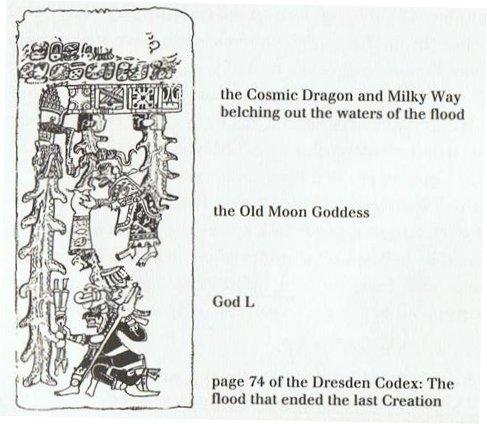If 27 should be a basic measure in the text,
then we can conclude those extra 11 glyphs hardly are
located at the end of side b because 324 = 12 * 27:
|
November
7 |
8 |
9 |
10 (314) |
 |
 |
 |
 |
|
Cb1-21
(413) |
Cb1-22 |
Cb1-23 |
Cb1-24 |
|
hoea |
ko
te rima |
kua
oo ki te vai |
ma te ua |
|
Botein
(46.9) |
ζ
Arietis (47.7), Zibal (48.0) |
no star
listed |
τ
Arietis (49.7),
Algenib Persei (50.0),
ο Tauri (50.2) |
|
Princeps (230.6), Zuben
Elschemali (230.8), μ Lupi, γ Tr. Austr. (231.3) |
ο Cor. Borealis (232.0),
δ Lupi (232.1), φ¹, ν² Lupi (232.2), ν¹ Lupi
(232.3), ε Lupi (232.4), φ² Lupi (232.5) |
Pherkad (232.6), η Cor.
Borealis (232.8), υ Lupi (232.9), Alkalurops (233.1) |
Nusakan
(234.0), κ Apodis
(234.3) |
|
321 |
September 28 |
29 |
30 (273) |
 |
 |
 |
|
Cb14-17 |
Cb14-18 |
Cb14-19 (740) |
|
e noi koe te manu
- kokoti hia te henua |
tagata hakaitiiti |
i te henua |
|
324 = 12 * 27 |
There are 12 * 27 = 324 days
from Gregorian day 314 (November 10) to
Gregorian day 273 (September 30). 365 + 273
- 314 = 324.
The 'half-submerged' glyphs can be
imagined as the result of the 'deluge' at the end of time.
The 'spout' in front at Cb14-17 can be compared with the
Mayan final in the last page of the Dresden codex:

Consequently the added 11 glyphs could be at
the beginning of side a:
|
September 20 |
21 (264) |
equinox |
 |
 |
 |
|
Ca1-1 |
Ca1-2 |
Ca1-3 |
|
koia |
ki te
hoea |
ki te henua |
|
September 23 |
24 |
25 |
26 |
 |
 |
 |
 |
|
Ca1-4 |
Ca1-5 |
Ca1-6 |
Ca1-7 |
|
te rima te hau tea -
haga i te mea ke - ki te henua - tagata
honui |
te ika |
|
September 27 |
28 |
29 |
30 (273) |
 |
 |
 |
 |
|
Ca1-8 |
Ca1-9 |
Ca1-10 |
Ca1-11 |
| te honu |
te manu te henua |
te
Rei |
In
the center of the figure in Ca1-6 there is the form of a
drop. 25 is a Saturn number and so is 11 at September 30.
The Fore and Rear Spouts in the manzil
calendar (cfr the Mayan illustration) ended after 354 (= 12 * 29½) days counted from
heliacal η Andromedae (April 1) - viz. at March 21 - while
the creator of the C text instead could have counted 12 * 27
(= 324) days from heliacal Algenib Persei - which was
visible close to the Full Moon in November 10 (314) - and
counted from where night 324 would be in September 30 (273 =
314 + 324 - 365).
|
0 |
- |
Zero |
η
Andromedae |
11.4 |
April 1 (91) |
- |
0 |
|
1 |
Al
Sharatain |
Pair
of Signs |
β
Arietis (Sheratan),
γ (Mesarthim) |
27.4 |
April 17 (107) |
16 |
16 |
| |
|
Musca Borealis |
35 (Head of the Fly), 39 (Kaffaljidhma), and
41
Arietis (Bharani) |
41.4 |
May
1 (121) |
14 |
30 |
|
2 |
Al
Dabarān |
Follower |
α
Tauri (Aldebaran), θ¹, θ²´,
γ
(Hyadum I),
δ (Hyadum II), ε (Ain) |
63.4 |
May
23 (143) |
22 |
52 |
|
21
stations |
|
24 |
Al Fargh al Mukdim |
Fore
Spout |
α
Pegasi (Markab), β (Scheat) |
349 |
March 5 (429) |
10 |
338 |
|
25 |
Al Fargh al Thāni |
Rear
Spout |
γ
Pegasi (Algenib),
α
Andromedae (Sirrah) |
0 |
March 21 (445) |
16 |
354 |
|
26 |
Al Batn Al Hūt |
Belly of the Fish |
β
Andromedae (Mirach) |
16.0 |
April 6 (461) |
16 |
370 |
|
27 |
Al Thurayya |
Many
Little Ones |
Messier 45 (Pleiades) |
56.3 |
May
16 (501) |
40 |
410 |
|
28 |
Al Butain |
The
Bellies |
δ
Arietis (Botein), ε, ρ³ |
|
|
|
|
The 'spout' of Aquarius was beginning
earlier in the year, apparently with Situla (κ)
at the end of February, and ending in March 15 when ω
rose with the Sun, appropriately close to the new
beginning at the March equinox:

|










